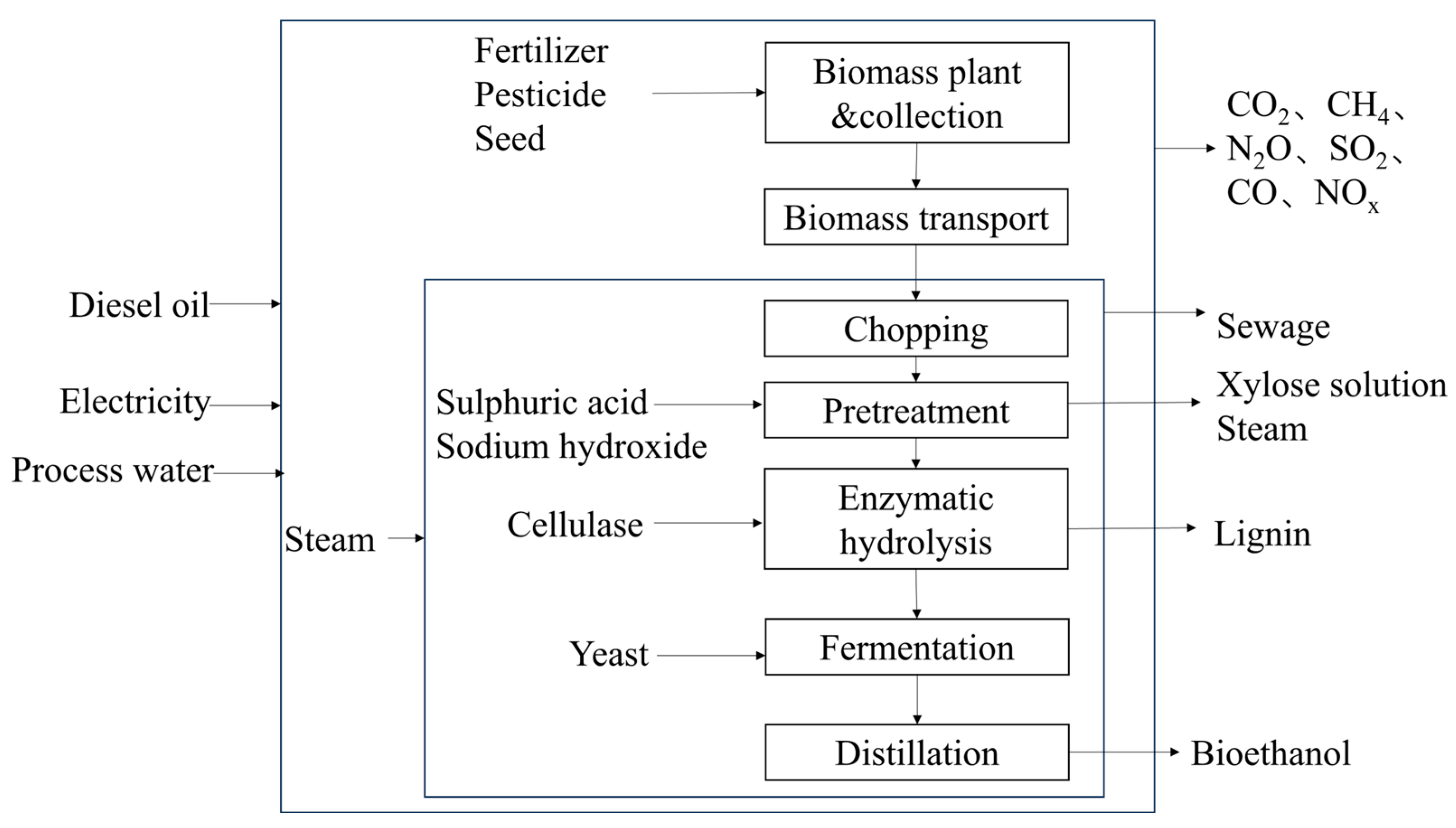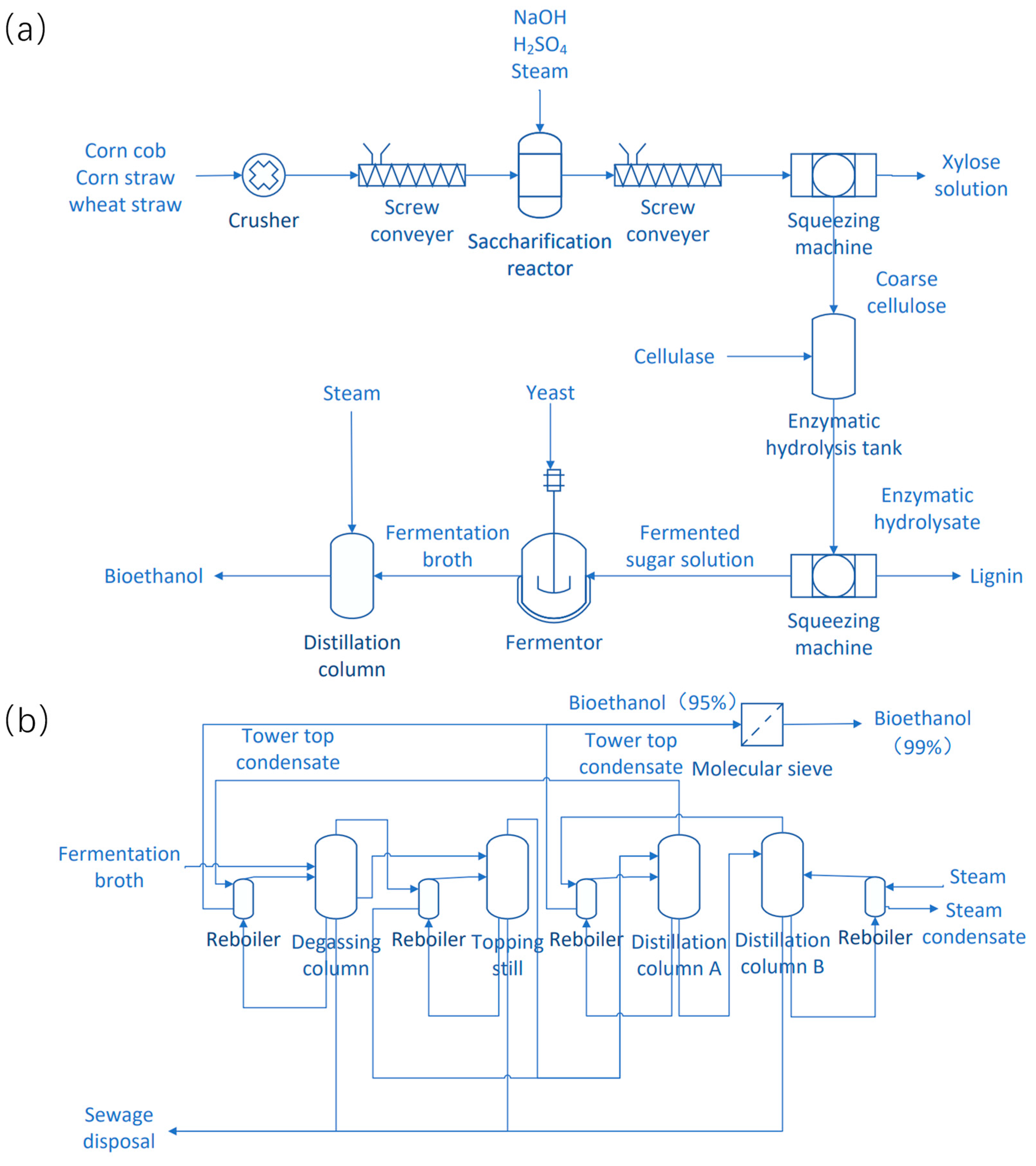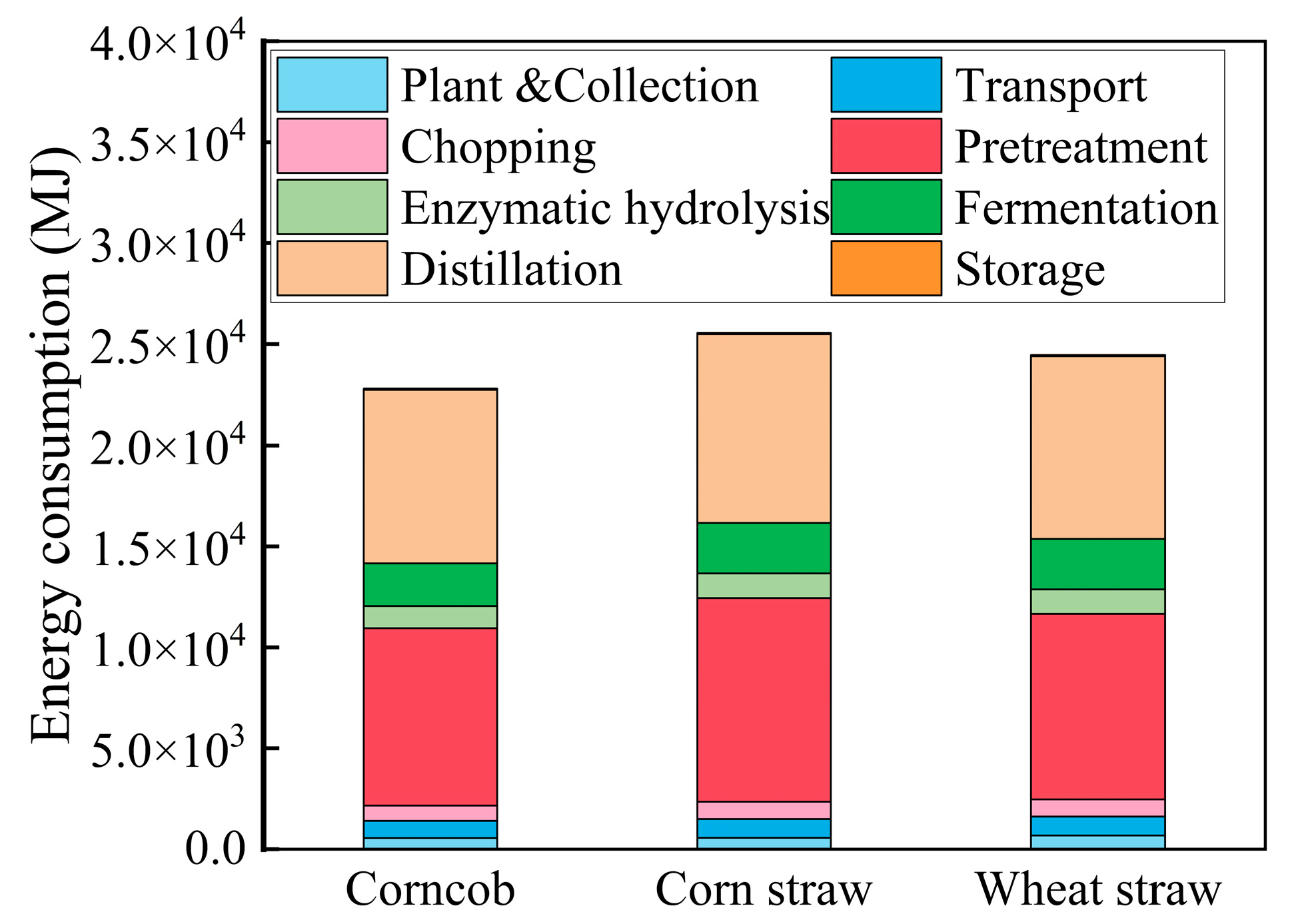Research on Life Cycle Assessment and Performance Comparison of Bioethanol Production from Various Biomass Feedstocks
Abstract
1. Introduction
2. Life Cycle System of Bioethanol
2.1. Purpose and Boundary Condition
2.2. The Assumptions in Calculation
2.3. Inventory Data and Source
2.3.1. Cultivation and Collection of Feedstocks
2.3.2. Calculation of Transport
2.3.3. Transforming Cellulose to Bioethanol
- (1)
- Chopping
- (2)
- Pretreatment
- (3)
- Enzymatic Hydrolysis and Fermentation
- (4)
- Distillation
2.4. Assessment Methods
2.4.1. Energy Impact
2.4.2. Environment Impact
3. Assessment of Process
3.1. Energy Efficiency
3.2. Environment Efficiency
3.3. Sensitivity Analysis and Uncertainty Analysis
3.4. Comparison to the Combined Heat and Power Generation of Lignin
4. Conclusions
Author Contributions
Funding
Institutional Review Board Statement
Informed Consent Statement
Data Availability Statement
Conflicts of Interest
References
- Hu, Y.; Du, H.; Xu, L.; Liang, C.; Zhang, Y.; Sun, Z.; Lin, C.S.K.; Wang, W.; Qi, W. Life cycle environmental benefits of recycling waste liquor and chemicals in production of lignocellulosic bioethanol. Bioresour. Technol. 2023, 390, 129855. [Google Scholar] [CrossRef]
- Yao, Y.; Xu, J.; Sun, D. Untangling global levelised cost of electricity based on multi-factor learning curve for renewable energy: Wind, solar, geothermal, hydropower and bioenergy. J. Clean. Prod. 2021, 285, 124827. [Google Scholar] [CrossRef]
- Zhou, X.; Li, G.; Liu, F.; Li, N. Production of ethanol from corn straw based on chemical looping gasification: Economic analysis. Bioresour. Technol. 2022, 360, 127568. [Google Scholar] [CrossRef]
- Feng, J.; Techapun, C.; Phimolsiripol, Y.; Phongthai, S.; Khemacheewakul, J.; Taesuwan, S.; Mahakuntha, C.; Porninta, K.; Htike, S.L.; Kumar, A.; et al. Utilization of agricultural wastes for co-production of xylitol, ethanol, and phenylacetylcarbinol: A review. Bioresour. Technol. 2024, 392, 129926. [Google Scholar] [CrossRef] [PubMed]
- Liu, F.; Guo, X.; Wang, Y.; Chen, G.; Hou, L. Process simulation and economic and environmental evaluation of a corncob-based biorefinery system. J. Clean. Prod. 2021, 329, 129707. [Google Scholar] [CrossRef]
- Prasad, S.; Singh, A.; Korres, N.E.; Rathore, D.; Sevda, S.; Pant, D. Sustainable utilization of crop residues for energy generation: A life cycle assessment (LCA) perspective. Bioresour. Technol. 2020, 303, 122964. [Google Scholar] [CrossRef] [PubMed]
- Zucaro, A.; Forte, A.; Fierro, A. Life cycle assessment of wheat straw lignocellulosic bio-ethanol fuel in a local biorefinery prospective. J. Clean. Prod. 2018, 194, 138–149. [Google Scholar] [CrossRef]
- Liu, F.; Short, M.D.; Alvarez-Gaitan, J.P.; Guo, X.; Duan, J.; Saint, C.; Chen, G.; Hou, L.A. Environmental life cycle assessment of lignocellulosic ethanol-blended fuels: A case study. J. Clean. Prod. 2020, 245, 118933. [Google Scholar] [CrossRef]
- Sivagurunathan, P.; Raj, T.; Mohanta, C.S.; Semwal, S.; Satlewal, A.; Gupta, R.P.; Puri, S.K.; Ramakumar, S.S.V.; Kumar, R. 2G waste lignin to fuel and high value-added chemicals: Approaches, challenges and future outlook for sustainable development. Chemosphere 2021, 268, 129326. [Google Scholar] [CrossRef]
- Morales, M.; Arvesen, A.; Cherubini, F. Integrated process simulation for bioethanol production: Effects of varying lignocellulosic feedstocks on technical performance. Bioresour. Technol. 2021, 328, 124833. [Google Scholar] [CrossRef]
- Rinke Dias De Souza, N.; Colling Klein, B.; Ferreira Chagas, M.; Cavalett, O.; Bonomi, A. Towards Comparable Carbon Credits: Harmonization of LCA Models of Cellulosic Biofuels. Sustainability 2021, 13, 10371. [Google Scholar] [CrossRef]
- Wang, X.; Guo, L.; Lv, J.; Li, M.; Huang, S.; Wang, Y.; Ma, X. Process design, modeling and life cycle analysis of energy consumption and GHG emission for jet fuel production from bioethanol in China. J. Clean. Prod. 2023, 389, 136027. [Google Scholar] [CrossRef]
- Borrion, A.L.; McManus, M.C.; Hammond, G.P. Environmental life cycle assessment of lignocellulosic conversion to ethanol: A review. Renew. Sust. Energy Rev. 2012, 16, 4638–4650. [Google Scholar] [CrossRef]
- Zhao, L.; Ou, X.; Chang, S. Life-cycle greenhouse gas emission and energy use of bioethanol produced from corn stover in China: Current perspectives and future prospectives. Energy 2016, 115, 303–313. [Google Scholar] [CrossRef]
- Wei, L.; Yang, H.; Niu, Y.; Zhang, Y.; Xu, L.; Chai, X. Wheat biomass, yield, and straw-grain ratio estimation from multi-temporal UAV-based RGB and multispectral images. Biosyst. Eng. 2023, 234, 187–205. [Google Scholar] [CrossRef]
- Lyu, H.; Zhang, J.; Zhai, Z.; Feng, Y.; Geng, Z. Life cycle assessment for bioethanol production from whole plant cassava by integrated process. J. Clean. Prod. 2020, 269, 121902. [Google Scholar] [CrossRef]
- Pang, B.; Sun, Z.; Wang, L.; Chen, W.; Sun, Q.; Cao, X.; Shen, X.; Xiao, L.; Yan, J.; Deuss, P.J.; et al. Improved value and carbon footprint by complete utilization of corncob lignocellulose. Chem. Eng. J. 2021, 419, 129565. [Google Scholar] [CrossRef]
- Soam, S.; Kapoor, M.; Kumar, R.; Borjesson, P.; Gupta, R.P.; Tuli, D.K. Global warming potential and energy analysis of second generation ethanol production from rice straw in India. Appl. Energy 2016, 184, 353–364. [Google Scholar] [CrossRef]
- Nation Development and Reform Commission. Compilation of National Agricultural Product Cost Benefit Information 2022; China Statistics Press: Beijing, China, 2022; pp. 128–134. [Google Scholar]
- He, R.; Dong, J.; Zhang, X.; Zheng, F.; Hu, Z. Dynamic Analysis of the Carbon Footprint in Winter Wheat Production Based on Lifecycle Assessment and the LMDI Model: A Case Study of Jiangsu Province in China. Sustainability 2023, 15, 12396. [Google Scholar] [CrossRef]
- Jayasundara, P.M.; Jayasinghe, T.K.; Rathnayake, M. Process Simulation Integrated Life Cycle Net Energy Analysis and GHG Assessment of Fuel-Grade Bioethanol Production from Unutilized Rice Straw. Waste Biomass Valori. 2022, 13, 3689–3705. [Google Scholar] [CrossRef]
- Huang, H.; Ramaswamy, S.; Al-Dajani, W.; Tschirner, U.; Cairncross, R.A. Effect of biomass species and plant size on cellulosic ethanol: A comparative process and economic analysis. Biomass Bioenergy 2009, 33, 234–246. [Google Scholar] [CrossRef]
- Miao, B. Life cycle energy efficiency evaluation of cellulose ethanol. Biotechnol. Bus. 2018, 41–44. [Google Scholar] [CrossRef]
- Toor, M.; Kumar, S.S.; Malyan, S.K.; Bishnoi, N.R.; Mathimani, T.; Rajendran, K.; Pugazhendhi, A. An overview on bioethanol production from lignocellulosic feedstocks. Chemosphere 2020, 242, 125080. [Google Scholar] [CrossRef] [PubMed]
- Sreekumar, A.; Shastri, Y.; Wadekar, P.; Patil, M.; Lali, A. Life cycle assessment of ethanol production in a rice-straw-based biorefinery in India. Clean. Technol. Environ. 2020, 22, 409–422. [Google Scholar] [CrossRef]
- Yu, Y.; Wu, J.; Ren, X.; Lau, A.; Rezaei, H.; Takada, M.; Bi, X.; Sokhansanj, S. Steam explosion of lignocellulosic biomass for multiple advanced bioenergy processes: A review. Renew. Sust. Energy Rev. 2022, 154, 111871. [Google Scholar] [CrossRef]
- Candido, R.G.; Mori, N.R.; Gonçalves, A.R. Sugarcane straw as feedstock for 2G ethanol: Evaluation of pretreatments and enzymatic hydrolysis. Ind. Crop Prod. 2019, 142, 111845. [Google Scholar] [CrossRef]
- Cotana, F.; Cavalaglio, G.; Gelosia, M.; Coccia, V.; Petrozzi, A.; Ingles, D.; Pompili, E. A comparison between SHF and SSSF processes from cardoon for ethanol production. Ind. Crop Prod. 2015, 69, 424–432. [Google Scholar] [CrossRef]
- Paulova, L.; Patakova, P.; Branska, B.; Rychtera, M.; Melzoch, K. Lignocellulosic ethanol: Technology design and its impact on process efficiency. Biotechnol. Adv. 2015, 33, 1091–1107. [Google Scholar] [CrossRef]
- Hossain, N.; Zaini, J.; Indra Mahlia, T.M. Life cycle assessment, energy balance and sensitivity analysis of bioethanol production from microalgae in a tropical country. Renew. Sustain. Energy Rev. 2019, 115, 109371. [Google Scholar] [CrossRef]
- Soam, S.; Kumar, R.; Gupta, R.P.; Sharma, P.K.; Tuli, D.K.; Das, B. Life cycle assessment of fuel ethanol from sugarcane molasses in northern and western India and its impact on Indian biofuel programme. Energy 2015, 83, 307–315. [Google Scholar] [CrossRef]
- Cueva Zepeda, L.; Griffin, G.; Shah, K.; Al-Waili, I.; Parthasarathy, R. Energy potential, flow characteristics and stability of water and alcohol-based rice-straw biochar slurry fuel. Renew. Energy 2023, 207, 60–72. [Google Scholar] [CrossRef]
- Jiao, J.; Li, J.; Bai, Y. Uncertainty analysis in the life cycle assessment of cassava ethanol in China. J. Clean. Prod. 2019, 206, 438–451. [Google Scholar] [CrossRef]
- Rodrigues, T.G.; Machado, R.L. Life Cycle Assessment of the Sugarcane Supply Chain in the Brazilian Midwest Region. Sustainability 2024, 16, 285. [Google Scholar] [CrossRef]
- Martinez-Hernandez, E.; Ibrahim, M.H.; Leach, M.; Sinclair, P.; Campbell, G.M.; Sadhukhan, J. Environmental sustainability analysis of UK whole-wheat bioethanol and CHP systems. Biomass Bioenergy 2013, 50, 52–64. [Google Scholar] [CrossRef]
- Xunfeng, X.; Jun, Z.; Beidou, X. Evaluation and Policy Research of Fuel Ethanol Based on Life Cycle; China Environmental Press: Beijing, China, 2011; pp. 77–81. [Google Scholar]
- Wang, M.; Han, J.; Dunn, J.B.; Cai, H.; Elgowainy, A. Well-to-wheels energy use and greenhouse gas emissions of ethanol from corn, sugarcane and cellulosic biomass for US use. Environ. Res. Lett. 2012, 7, 45905–45913. [Google Scholar] [CrossRef]
- Nogueira, G.P.; Capaz, R.S.; Franco, T.T.; Dias, M.O.S.; Cavaliero, C.K.N. Enzymes as an environmental bottleneck in cellulosic ethanol production: Does on-site production solve it? J. Clean. Prod. 2022, 369, 133314. [Google Scholar] [CrossRef]
- Espada, J.J.; Villalobos, H.; Rodríguez, R. Environmental assessment of different technologies for bioethanol production from Cynara cardunculus: A Life Cycle Assessment study. Biomass Bioenergy 2021, 144, 105910. [Google Scholar] [CrossRef]
- Li, J.; Tian, Y.; Xie, K. Coupling big data and life cycle assessment: A review, recommendations, and prospects. Ecol. Indic. 2023, 153, 110455. [Google Scholar] [CrossRef]
- Yang, Y.; Liang, S.; Yang, Y.; Xie, G.H.; Zhao, W. Spatial disparity of life-cycle greenhouse gas emissions from corn straw-based bioenergy production in China. Appl. Energy 2022, 305, 117854. [Google Scholar] [CrossRef]
- Yang, Y. Two sides of the same coin: Consequential life cycle assessment based on the attributional framework. J. Clean. Prod. 2016, 127, 274–281. [Google Scholar] [CrossRef]
- Hiloidhari, M.; Haran, S.; Banerjee, R.; Rao, A.B. Life cycle energy–carbon–water footprints of sugar, ethanol and electricity from sugarcane. Bioresour. Technol. 2021, 330, 125012. [Google Scholar] [CrossRef] [PubMed]
- Cherubini, F.; Strømman, A.H.; Ulgiati, S. Influence of allocation methods on the environmental performance of biorefinery products—A case study. Resour. Conserv. Recycl. 2011, 55, 1070–1077. [Google Scholar] [CrossRef]
- Awasthi, M.K.; Sindhu, R.; Sirohi, R.; Kumar, V.; Ahluwalia, V.; Binod, P.; Juneja, A.; Kumar, D.; Yan, B.; Sarsaiya, S.; et al. Agricultural waste biorefinery development towards circular bioeconomy. Renew. Sustain. Energy Rev. 2022, 158, 112122. [Google Scholar] [CrossRef]
- Cherubini, F.; Ulgiati, S. Crop residues as raw materials for biorefinery systems—A LCA case study. Appl. Energy 2010, 87, 47–57. [Google Scholar] [CrossRef]
- Liu, F.; Chen, G.; Yan, B.; Ma, W.; Cheng, Z.; Hou, L. Exergy analysis of a new lignocellulosic biomass-based polygeneration system. Energy 2017, 140, 1087–1095. [Google Scholar] [CrossRef]





| Price ($) | Grass Grain Ratio | Ratio | |
|---|---|---|---|
| Corn | 356.32 | 72.65% | |
| Corn straw | 70.90 | 1.73 * | 25.01% |
| Corn cob | 76.46 | 0.15 [17] | 2.34% |
| Wheat | 347.56 | 78.21% | |
| Wheat straw | 70.90 | 1.34 * | 21.79% |
| Raw Materials | Corn Cob | Corn Straw | Wheat Straw |
|---|---|---|---|
| Nitrogenous fertilizer (kg) | 8.23 | 8.36 | 22.61 |
| Phosphate fertilizer (kg) | 0.61 | 0.62 | 0.75 |
| Potassium fertilizer (kg) | 0.04 | 0.05 | 0.05 |
| Diesel fuel (kg) | 11.20 | 11.38 | 13.29 |
| Electricity (kWh) | 33.73 | 34.26 | 47.39 |
| Insecticide (kg) | 0.15 | 0.15 | 0.27 |
| Herbicide (kg) | 0.41 | 0.41 | 0.24 |
| Transportation Volume (Mg) | Distance (km) | Consumption (L) | Density (kg/L) | Fuel Volume (Mg) | |
|---|---|---|---|---|---|
| Corn cob | 5.24 | 100 | 0.05 | 0.85 | 2.21 × 10−2 |
| Corn straw | 5.69 | 100 | 0.05 | 0.85 | 2.42 × 10−2 |
| Wheat straw | 5.71 | 100 | 0.05 | 0.85 | 2.42 × 10−2 |
| Corn Cob | Corn Straw | Wheat Straw | |
|---|---|---|---|
| Input | |||
| Biomass raw materials (dry basis) (Mg) | 5.24 | 5.69 | 5.71 |
| Sulfuric acid (Mg) | 0.047 | 0.055 | 0.053 |
| Primary steam (Mg) | 8.33 | 8.97 | 8.76 |
| Process water (Mg) | 29.44 | 30.83 | 30.92 |
| Sodium hydroxide (Mg) | 0.039 | 0.045 | 0.043 |
| Cellulase (Mg) | 0.079 | 0.085 | 0.085 |
| Yeast (Mg) | 0.000340 | 0.000350 | 0.000345 |
| Electricity (kWh) | 1100 | 1250 | 1250 |
| Output | |||
| Ethanol (Mg) | 1.00 | 1.00 | 1.00 |
| Lignin (dry basis) (Mg) | 1.43 | 1.71 | 1.73 |
| Xylose solution (Mg) | 18.81 | 19.14 | 18.81 |
| Recycling water vapor (Mg) | 1.82 | 1.74 | 1.98 |
| Wastewater (Mg) | 19.52 | 21.31 | 21.38 |
| CO2 (Mg) | 0.96 | 0.96 | 0.96 |
| Energy (MJ/Mg) | |
|---|---|
| Diesel fuel | 3.86 × 104 |
| Primary steam | 2.69 × 103 |
| Electricity (kWh) | 3.60 |
| Substance | GWP (kg CO2 eq) a | AP (kg SO2 eq) b | EP (kg PO43− eq) c | POCP (kg C2H4 eq) d | HTP (kg 1,4-DB eq) e |
|---|---|---|---|---|---|
| CO2 | 1 | ||||
| CH4 | 25 | 0.007 | |||
| N2O | 298 | 0.27 | |||
| CO | 2 | 0.012 | |||
| NOX | 0.7 | 0.1 | 0.78 | ||
| SOX | 2 | 1.2 | |||
| SO2 | 1 | ||||
| PO43- | 1 |
| Corn Cob | Corn Straw | Wheat Straw | |
|---|---|---|---|
| NEB (MJ/Mg) | 6902.10 | 4172.96 | 5236.06 |
| NER | 1.30 | 1.16 | 1.21 |
| Distribution Method: | Corn Cob | Corn Straw | Wheat Straw | |||
|---|---|---|---|---|---|---|
| NEB (MJ/Mg) | NER | NEB (MJ/Mg) | NER | NEB (MJ/Mg) | NER | |
| Unallocated | 6902 | 1.30 | 4172 | 1.16 | 5236 | 1.21 |
| Economic distribution | 11,090 | 1.60 | 8794 | 1.42 | 9824 | 1.49 |
| Comprehensive allocation | 13,213 | 1.80 | 11,497 | 1.63 | 12,199 | 1.70 |
| Distribution Method: | GWP | GHG Reduction | AP | EP | POCP | HTP | |
|---|---|---|---|---|---|---|---|
| Corn cob | Unallocated | 1.75 × 10−2 | 54% | 1.02 × 10−2 | 2.63 × 10−4 | 3.19 × 10−8 | 1.52 × 10−4 |
| Economic distribution | 1.53 × 10−2 | 60% | 8.90 × 10−3 | 2.30 × 10−4 | 2.83 × 10−8 | 1.33 × 10−4 | |
| Comprehensive allocation | 1.23 × 10−2 | 66% | 7.19 × 10−3 | 1.85 × 10−4 | 2.38 × 10−8 | 1.10 × 10−4 | |
| Corn straw | Unallocated | 1.96 × 10−2 | 49% | 1.15 × 10−2 | 2.91 × 10−4 | 3.43 × 10−8 | 1.71 × 10−4 |
| Economic distribution | 1.71 × 10−2 | 55% | 1.00 × 10−2 | 2.54 × 10−4 | 3.16 × 10−8 | 1.50 × 10−4 | |
| Comprehensive allocation | 1.36 × 10−2 | 63% | 8.00 × 10−3 | 2.02 × 10−4 | 2.62 × 10−8 | 1.22 × 10−4 | |
| Wheat straw | Unallocated | 1.99 × 10−2 | 48% | 1.17 × 10−2 | 2.98 × 10−4 | 3.82 × 10−8 | 1.74 × 10−4 |
| Economic distribution | 1.74 × 10−2 | 54% | 1.02 × 10−2 | 2.60 × 10−4 | 3.42 × 10−8 | 1.53 × 10−4 | |
| Comprehensive allocation | 1.38 × 10−2 | 62% | 8.13 × 10−3 | 2.07 × 10−4 | 2.89 × 10−8 | 1.26 × 10−4 |
| Lignin Products | Electricity | |||||
|---|---|---|---|---|---|---|
| Corn Cob | Corn Straw | Wheat Straw | Corn Cob | Corn Straw | Wheat Straw | |
| NEB (MJ/Mg) | 10,688 | 8797 | 8728 | 10,679 | 8736 | 8820 |
| NER | 1.56 | 1.42 | 1.42 | 1.56 | 1.41 | 1.41 |
| GHG reduction | 66% | 63% | 62% | 29% | 19% | 17% |
| Economy | 1359 | 1624 | 1648 | 811 | 985 | 985 |
Disclaimer/Publisher’s Note: The statements, opinions and data contained in all publications are solely those of the individual author(s) and contributor(s) and not of MDPI and/or the editor(s). MDPI and/or the editor(s) disclaim responsibility for any injury to people or property resulting from any ideas, methods, instructions or products referred to in the content. |
© 2024 by the authors. Licensee MDPI, Basel, Switzerland. This article is an open access article distributed under the terms and conditions of the Creative Commons Attribution (CC BY) license (https://creativecommons.org/licenses/by/4.0/).
Share and Cite
Yin, T.; Huhe, T.; Li, X.; Wang, Q.; Lei, T.; Zhou, Z. Research on Life Cycle Assessment and Performance Comparison of Bioethanol Production from Various Biomass Feedstocks. Sustainability 2024, 16, 1788. https://doi.org/10.3390/su16051788
Yin T, Huhe T, Li X, Wang Q, Lei T, Zhou Z. Research on Life Cycle Assessment and Performance Comparison of Bioethanol Production from Various Biomass Feedstocks. Sustainability. 2024; 16(5):1788. https://doi.org/10.3390/su16051788
Chicago/Turabian StyleYin, Tianyi, Taoli Huhe, Xueqin Li, Qian Wang, Tingzhou Lei, and Zhengzhong Zhou. 2024. "Research on Life Cycle Assessment and Performance Comparison of Bioethanol Production from Various Biomass Feedstocks" Sustainability 16, no. 5: 1788. https://doi.org/10.3390/su16051788
APA StyleYin, T., Huhe, T., Li, X., Wang, Q., Lei, T., & Zhou, Z. (2024). Research on Life Cycle Assessment and Performance Comparison of Bioethanol Production from Various Biomass Feedstocks. Sustainability, 16(5), 1788. https://doi.org/10.3390/su16051788







